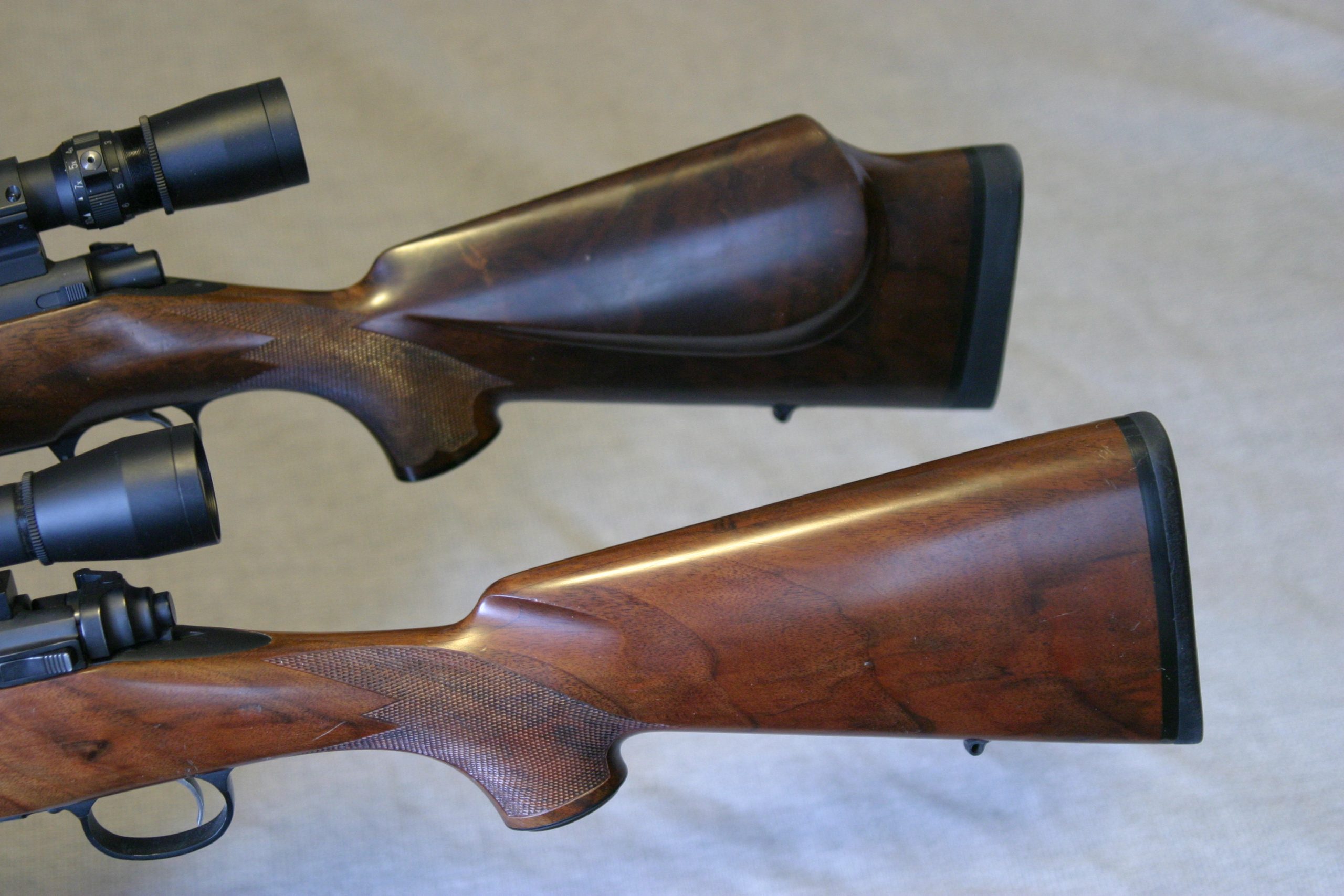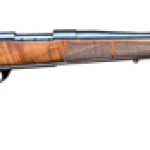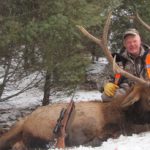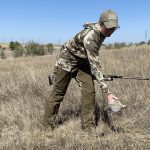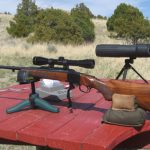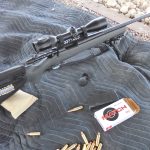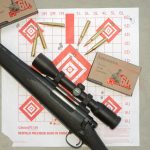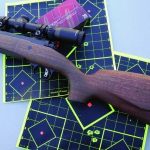Women shoot better with rifles that fit them well, just as men do.
Photo above: The top rifle is Eileen Clarke’s .308 Winchester, made by Gene Gordner to fit her, since like many women she has sloping shoulders and a relatively long neck. The bottom is Barsness’s 7×57, made by Gordner to fit his square shoulders and a relatively short neck.

One interesting fact often lost in the pessimism about declining hunting license sales is that the number of women hunters continues to rise. About 20 percent of Americans who buy hunting licenses are now female, and in some parts of the country, the percentage may even be higher. Here in Montana, one of four states where more than 25 percent of residents hunt, all new license buyers must take a hunter-safety course. In my small town, the most recent class was half girls.
Consequently, more hunting rifles are being made specifically for women. When my wife started hunting in the early 1980s, the primary factory option was a “youth rifle,” the same basic rifle made for adults but shortened at both ends. Luckily, Eileen was only slightly shorter than the average American male, so she could use a “standard” hunting rifle, with the 13. 5-inch length of pull designed for a man about 5 feet 9 inches tall.
But other differences soon became apparent. We didn’t have much spare money back then, so she used one of my family’s heirloom rifles, the Remington 722 .257 Roberts given to my paternal grandmother, acquired in 1953. The first thing I did was work up a handload approximating factory ballistics, a 100-grain bullet at 2,900 fps.
Eileen practiced considerably with a pellet rifle and .22 rimfire before trying the .257 a couple of months before hunting season. I assured her it didn’t kick hard, but at the first shot she yelped and rubbed her shoulder. That was due to one common difference between women and men–not as much muscle over the shoulder joint.

It was August, so she was wearing a thin cotton shirt, and the Remington had an aluminum buttplate, which hurt. Luckily, I had a towel in my range kit. Doubled a couple times, it served as a shoulder pad, and soon we discovered a relatively light hunting jacket provided sufficient padding in the field. Of course, nowadays even affordable factory rifles usually have recoil pads, but the harder rubber pads found on many older factory rifles (and even some made today) can be uncomfortable for women to shoot due to some of their physical characteristics.
On average, men tend to have squarer shoulders and shorter necks, while women tend to have longer necks and more sloping shoulders. This is why many men are convinced the straight-combed, classic-style buttstock reduces felt recoil. For many men it does, because their square shoulders aren’t that much lower than their faces, especially after leaning the head forward when aiming. As a result, recoil shoves the rifle back in a relatively straight line, reducing upward jump, and the butt pad makes plenty of contact with the shoulder.
Unfortunately, when women with sloping shoulders and longer necks shoot a classic stock, the pad sits higher on their shoulder, often with the “toe” of the pad on the middle of the joint. On classic stocks the toe is often pointy, apparently for aesthetic reasons, so it jabs many women in the least-muscled part of their shoulder.
However, even a hard-rubber recoil pad that fits better can still hurt, because nerve-filled breast tissue extends upward to the area between the collarbone and shoulder. A straight buttstock also tends to prevent a good “cheek weld” in women with longer necks, so their cheekbone gets whacked as the rifle rises in recoil. This can be just as painful as being jabbed in the shoulder.
Consequently, many women find a Monte Carlo stock more comfortable to shoot and easier to aim. The raised cheekpiece allows them to look comfortably through a scope, while the lower recoil pad contacts more of their shoulder, spreading kick over a larger area.
This has been known to some custom stockmakers for quite a while, especially those who make stocks to fit a specific customer, rather than making one basic stock (often classic style) and only changing the length of pull. Eileen eventually ended up with exactly such a stock, thanks to Gene Gordner, the stockmaker for what was then Serengeti Rifles, and is now Kilimanjaro Rifles.
Eileen spent a couple hours in Gene’s shop while he did the final fitting for a walnut-stocked .308 Winchester built on a Kimber 84 action. Despite it being chambered in a larger cartridge and weighing a pound less than the old .257, her new rifle kicked a lot less. (Eileen also says the rifle points so naturally it’s like cheating: When she raises it to her shoulder, the scope is right on the animal.)
Not so coincidentally, when Weatherby introduced its Camilla rifle a few years ago—“designed by women for women”—the stock’s dimensions were very similar to the Eileen’s .308. In fact, when she picked up a Camilla (named for Roy Weatherby’s wife) in a local sporting goods store, she remarked that somebody finally got it right.
It’s also not a coincidence that Roy Weatherby was fond of Monte Carlo stocks. He had more sloping shoulders and a longer neck than most men, which is why some men also find Weatherby-style stocks more comfortable than classic stocks. Even though women and men are obviously built differently, there’s still considerable crossover in shoulder and neck dimensions, and that’s why some women can comfortably use classic-stocked big-game rifles.
Of course, many men are convinced women can’t use “real” big game cartridges (generally defined as anything from .300 magnums up) because of the increased recoil. Until recently, most women were introduced to hunting by men (primarily their fathers or husbands), which resulted in an odd contradiction: Many of the men were convinced that women can only use wimpy cartridges, such as the .243 Winchester for deer, or something in the .270/7×57/.308 class for larger game.
Even Elmer Keith, the legendary “big bore” advocate, once wrote that he considered a .33-caliber bullet weighing 250 grains the minimum for elk and even big mule deer. Yet he often suggested rounds like the 7×57 for women.
This still isn’t an uncommon attitude. I know one guy, a decade or so older than me, who remains convinced that elk can only be adequately slain with a Keithian cartridge such as the .338 Winchester or .340 Weatherby Magnum. This resulted in an interesting conversation at a hunting camp, when one of the women present asked him, “So why do men need bigger cartridges to kill the same animals women drop with smaller ones?”
Of course, just as some women are suitably built for classic stocks, some are comfortable with considerable recoil, which often doesn’t have anything to do with being big or strong. One prime example is Coni Brooks, co-founder of Barnes Bullets. Coni is smaller than most women, yet prefers the .338 Winchester Magnum as her “light” big-game rifle, whether deer for hunting deer and elk in North America, or plains game in Africa. And she shoots the .338 very well.
Phoebe Haefele is the daughter of my good friend Fred, and she wanted not just a deer rifle but something suitable for elk. Instead of assuming what she needed, Eileen and I invited her to try some of our collection, chambered for cartridges from the 6.5×55 to the .30-06, with various stock shapes, and we’d loan her whichever rifle she liked best.
Phoebe’s about the same height as Eileen, and has been shooting quite a bit already. She shot allof the rifles well, but picked a 7mm-08 Remington, a tang-safety Ruger 77 that had been rebarreled with a light-contour Douglas barrel. I’d found it shot great with Hornady’s American Whitetail factory load with 139-grain Interlocks, and also shot a handload with 140-grain Barnes Tipped TSXs to the same place. She used one Hornady to take her first big-game animal, a whitetail doe, with a perfectly placed shot at 160 yards, but did not find an elk. Maybe next year!
But in the meantime, Phoebe found a rifle she shot well, not through somebody else making the decision, but by trying several to see how they suited her. And that is the best way for any hunter to choose a big-game rifle.
Two Rifles Made for Women
Two manufacturers have designed rifles specifically tailored to women. Weatherby’s Camilla rifle incorporates a high comb, a buttstock that is angled away from the body, and a slim pistol grip. The 13-inch length of pull and a slender fore-end reduce overall weight and length without compromising feel and balance.
The Savage Model 11 Lady Hunter also incorporates a raised comb and slender grip and fore-end. Length of pull is 12.5 inches, and the balance point of the 20-inch light-taper barrel has been shifted for proper balance.



